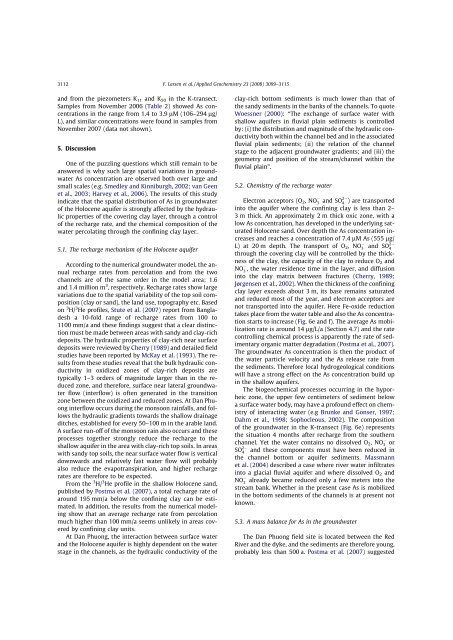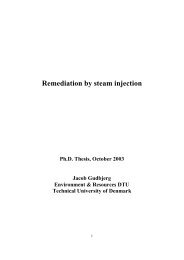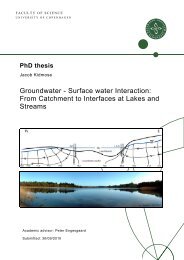Groundwater arsenic in the Red River delta, Vietnam ... - Fiva
Groundwater arsenic in the Red River delta, Vietnam ... - Fiva
Groundwater arsenic in the Red River delta, Vietnam ... - Fiva
Create successful ePaper yourself
Turn your PDF publications into a flip-book with our unique Google optimized e-Paper software.
3112 F. Larsen et al. / Applied Geochemistry 23 (2008) 3099–3115<br />
and from <strong>the</strong> piezometers K 11 and K 50 <strong>in</strong> <strong>the</strong> K-transect.<br />
Samples from November 2006 (Table 2) showed As concentrations<br />
<strong>in</strong> <strong>the</strong> range from 1.4 to 3.9 lM (106–294 lg/<br />
L), and similar concentrations were found <strong>in</strong> samples from<br />
November 2007 (data not shown).<br />
5. Discussion<br />
One of <strong>the</strong> puzzl<strong>in</strong>g questions which still rema<strong>in</strong> to be<br />
answered is why such large spatial variations <strong>in</strong> groundwater<br />
As concentration are observed both over large and<br />
small scales (e.g. Smedley and K<strong>in</strong>niburgh, 2002; van Geen<br />
et al., 2003; Harvey et al., 2006). The results of this study<br />
<strong>in</strong>dicate that <strong>the</strong> spatial distribution of As <strong>in</strong> groundwater<br />
of <strong>the</strong> Holocene aquifer is strongly affected by <strong>the</strong> hydraulic<br />
properties of <strong>the</strong> cover<strong>in</strong>g clay layer, through a control<br />
of <strong>the</strong> recharge rate, and <strong>the</strong> chemical composition of <strong>the</strong><br />
water percolat<strong>in</strong>g through <strong>the</strong> conf<strong>in</strong><strong>in</strong>g clay layer.<br />
5.1. The recharge mechanism of <strong>the</strong> Holocene aquifer<br />
Accord<strong>in</strong>g to <strong>the</strong> numerical groundwater model, <strong>the</strong> annual<br />
recharge rates from percolation and from <strong>the</strong> two<br />
channels are of <strong>the</strong> same order <strong>in</strong> <strong>the</strong> model area; 1.6<br />
and 1.4 million m 3 , respectively. Recharge rates show large<br />
variations due to <strong>the</strong> spatial variability of <strong>the</strong> top soil composition<br />
(clay or sand), <strong>the</strong> land use, topography etc. Based<br />
on 3 H/ 3 He profiles, Stute et al. (2007) report from Bangladesh<br />
a 10-fold range of recharge rates from 100 to<br />
1100 mm/a and <strong>the</strong>se f<strong>in</strong>d<strong>in</strong>gs suggest that a clear dist<strong>in</strong>ction<br />
must be made between areas with sandy and clay-rich<br />
deposits. The hydraulic properties of clay-rich near surface<br />
deposits were reviewed by Cherry (1989) and detailed field<br />
studies have been reported by McKay et al. (1993). The results<br />
from <strong>the</strong>se studies reveal that <strong>the</strong> bulk hydraulic conductivity<br />
<strong>in</strong> oxidized zones of clay-rich deposits are<br />
typically 1–3 orders of magnitude larger than <strong>in</strong> <strong>the</strong> reduced<br />
zone, and <strong>the</strong>refore, surface near lateral groundwater<br />
flow (<strong>in</strong>terflow) is often generated <strong>in</strong> <strong>the</strong> transition<br />
zone between <strong>the</strong> oxidized and reduced zones. At Dan Phuong<br />
<strong>in</strong>terflow occurs dur<strong>in</strong>g <strong>the</strong> monsoon ra<strong>in</strong>falls, and follows<br />
<strong>the</strong> hydraulic gradients towards <strong>the</strong> shallow dra<strong>in</strong>age<br />
ditches, established for every 50–100 m <strong>in</strong> <strong>the</strong> arable land.<br />
A surface run-off of <strong>the</strong> monsoon ra<strong>in</strong> also occurs and <strong>the</strong>se<br />
processes toge<strong>the</strong>r strongly reduce <strong>the</strong> recharge to <strong>the</strong><br />
shallow aquifer <strong>in</strong> <strong>the</strong> area with clay-rich top soils. In areas<br />
with sandy top soils, <strong>the</strong> near surface water flow is vertical<br />
downwards and relatively fast water flow will probably<br />
also reduce <strong>the</strong> evapotranspiration, and higher recharge<br />
rates are <strong>the</strong>refore to be expected.<br />
From <strong>the</strong> 3 H/ 3 He profile <strong>in</strong> <strong>the</strong> shallow Holocene sand,<br />
published by Postma et al. (2007), a total recharge rate of<br />
around 195 mm/a below <strong>the</strong> conf<strong>in</strong><strong>in</strong>g clay can be estimated.<br />
In addition, <strong>the</strong> results from <strong>the</strong> numerical model<strong>in</strong>g<br />
show that an average recharge rate from percolation<br />
much higher than 100 mm/a seems unlikely <strong>in</strong> areas covered<br />
by conf<strong>in</strong><strong>in</strong>g clay units.<br />
At Dan Phuong, <strong>the</strong> <strong>in</strong>teraction between surface water<br />
and <strong>the</strong> Holocene aquifer is highly dependent on <strong>the</strong> water<br />
stage <strong>in</strong> <strong>the</strong> channels, as <strong>the</strong> hydraulic conductivity of <strong>the</strong><br />
clay-rich bottom sediments is much lower than that of<br />
<strong>the</strong> sandy sediments <strong>in</strong> <strong>the</strong> banks of <strong>the</strong> channels. To quote<br />
Woessner (2000): ‘‘The exchange of surface water with<br />
shallow aquifers <strong>in</strong> fluvial pla<strong>in</strong> sediments is controlled<br />
by: (i) <strong>the</strong> distribution and magnitude of <strong>the</strong> hydraulic conductivity<br />
both with<strong>in</strong> <strong>the</strong> channel bed and <strong>in</strong> <strong>the</strong> associated<br />
fluvial pla<strong>in</strong> sediments; (ii) <strong>the</strong> relation of <strong>the</strong> channel<br />
stage to <strong>the</strong> adjacent groundwater gradients; and (iii) <strong>the</strong><br />
geometry and position of <strong>the</strong> stream/channel with<strong>in</strong> <strong>the</strong><br />
fluvial pla<strong>in</strong>”.<br />
5.2. Chemistry of <strong>the</strong> recharge water<br />
Electron acceptors (O2,NO3and SO 2<br />
4 ) are transported<br />
<strong>in</strong>to <strong>the</strong> aquifer where <strong>the</strong> conf<strong>in</strong><strong>in</strong>g clay is less than 2–<br />
3 m thick. An approximately 2 m thick oxic zone, with a<br />
low As concentration, has developed <strong>in</strong> <strong>the</strong> underly<strong>in</strong>g saturated<br />
Holocene sand. Over depth <strong>the</strong> As concentration <strong>in</strong>creases<br />
and reaches a concentration of 7.4 lM As (555 lg/<br />
L) at 20 m depth. The transport of O2, NO3and SO 2<br />
4<br />
through <strong>the</strong> cover<strong>in</strong>g clay will be controlled by <strong>the</strong> thickness<br />
of <strong>the</strong> clay, <strong>the</strong> capacity of <strong>the</strong> clay to reduce O2 and<br />
NO3 , <strong>the</strong> water residence time <strong>in</strong> <strong>the</strong> layer, and diffusion<br />
<strong>in</strong>to <strong>the</strong> clay matrix between fractures (Cherry, 1989;<br />
Jørgensen et al., 2002). When <strong>the</strong> thickness of <strong>the</strong> conf<strong>in</strong><strong>in</strong>g<br />
clay layer exceeds about 3 m, its base rema<strong>in</strong>s saturated<br />
and reduced most of <strong>the</strong> year, and electron acceptors are<br />
not transported <strong>in</strong>to <strong>the</strong> aquifer. Here Fe-oxide reduction<br />
takes place from <strong>the</strong> water table and also <strong>the</strong> As concentration<br />
starts to <strong>in</strong>crease (Fig. 6e and f). The average As mobilization<br />
rate is around 14 lg/L/a (Section 4.7) and <strong>the</strong> rate<br />
controll<strong>in</strong>g chemical process is apparently <strong>the</strong> rate of sedimentary<br />
organic matter degradation (Postma et al., 2007).<br />
The groundwater As concentration is <strong>the</strong>n <strong>the</strong> product of<br />
<strong>the</strong> water particle velocity and <strong>the</strong> As release rate from<br />
<strong>the</strong> sediments. Therefore local hydrogeological conditions<br />
will have a strong effect on <strong>the</strong> As concentration build up<br />
<strong>in</strong> <strong>the</strong> shallow aquifers.<br />
The biogeochemical processes occurr<strong>in</strong>g <strong>in</strong> <strong>the</strong> hyporheic<br />
zone, <strong>the</strong> upper few centimeters of sediment below<br />
a surface water body, may have a profound effect on chemistry<br />
of <strong>in</strong>teract<strong>in</strong>g water (e.g Brunke and Gonser, 1997;<br />
Dahm et al., 1998; Sophocleous, 2002). The composition<br />
of <strong>the</strong> groundwater <strong>in</strong> <strong>the</strong> K-transect (Fig. 6e) represents<br />
<strong>the</strong> situation 4 months after recharge from <strong>the</strong> sou<strong>the</strong>rn<br />
channel. Yet <strong>the</strong> water conta<strong>in</strong>s no dissolved O2, NO3or SO 2<br />
4<br />
and <strong>the</strong>se components must have been reduced <strong>in</strong><br />
<strong>the</strong> channel bottom or aquifer sediments. Massmann<br />
et al. (2004) described a case where river water <strong>in</strong>filtrates<br />
<strong>in</strong>to a glacial fluvial aquifer and where dissolved O2 and<br />
NO 3 already became reduced only a few meters <strong>in</strong>to <strong>the</strong><br />
stream bank. Whe<strong>the</strong>r <strong>in</strong> <strong>the</strong> present case As is mobilized<br />
<strong>in</strong> <strong>the</strong> bottom sediments of <strong>the</strong> channels is at present not<br />
known.<br />
5.3. A mass balance for As <strong>in</strong> <strong>the</strong> groundwater<br />
The Dan Phuong field site is located between <strong>the</strong> <strong>Red</strong><br />
<strong>River</strong> and <strong>the</strong> dyke, and <strong>the</strong> sediments are <strong>the</strong>refore young,<br />
probably less than 500 a. Postma et al. (2007) suggested





